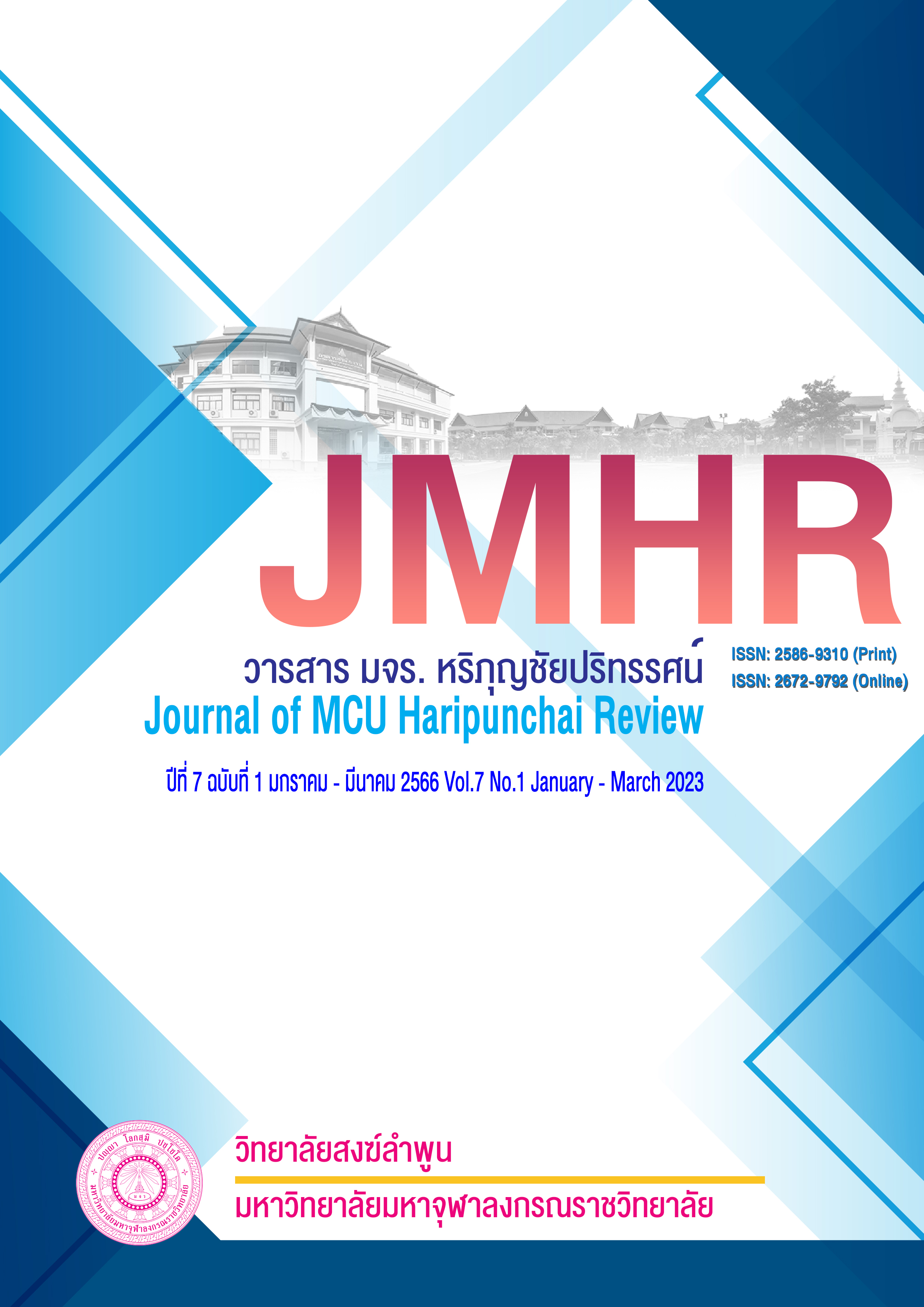Tung Sam Hang Tung Sam Hang: Buddhist Philosophy in Lan Na
Main Article Content
Abstract
This article is a study of the Tung Sam Hang (Three-tailed Flag) dhamma riddle in Lan Na. It found that “Tung” means flag in the Lan Na’s Arts in the Northern of Thailand. Most of them have made from fabric, wooden or thread which is shown the riddle of Buddhism which start from Buddhism age and also shown in Thachaggasutra. The first, there are 2 ceremonies for Tung; 1. Happy Ceremony such as Kathina ceremony, house warming ceremony. 2. Sad Ceremony such as Funeral. For the Tung Sam Hang (Three-tailed Flag) is the Lan Na Buddhism’s ceremony for the death. Tung is the art’s flag in the past which would like to teach Buddhism lesson. We find that, in the flag art of Buddhist philosophy, Tung Sam Hang is symbolic of the deceased. The flag is pinned to the front of the coffin and conveyed with it to the graveyard. It represents a dhamma riddle with three meanings: (1) The cycle of life or Vaṭṭa, the threefold round of birth, death, and rebirth, which is the cycle of suffering and has three parts: (1) The cycle of defilements, Kilesa-vatta, which is the cause of birth and death; (2) The cycle of kamma or Kamma-vaṭṭa, the round of physical, verbal and mental actions which cause effects; and (3) The cycle of Vipāka-vaṭṭa, the round of consequences or the effects of kamma. This threefold cycle is unending. (2) That which essentially conveys the core of Buddhist morality: Tilakkhaṇa, the three marks of existence. Tilakkhana consists of Aniccā (impermanence), Dukkha (suffering) and Anattā (non-self). (3). Faith in the Triple Gem of Buddhism. When the dead depart, they will have the Triple Gem on which to depend, and be freed from Apāyabhūmi (the four planes of loss and woe).
Article Details

This work is licensed under a Creative Commons Attribution-NonCommercial-NoDerivatives 4.0 International License.
References
มหาจุฬาลงกรณราชวิทยาลัย. (2539). พระไตรปิฎกภาษาไทย ฉบับมหาจุฬาลงกรณราชวิทยาลัย. พิมพ์เฉลิมพระเกียรติสมเด็จพระนางเจ้าสิริกิติ์ฯ เนื่องในงานมหามงคลสมัยเฉลิมพระชนมพรรษา 5 รอบ 12 สิงหาคม 2535. กรุงเทพมหานคร : โรงพิมพ์มหาจุฬาลงกรณราชวิทยาลัย.
มหามกุฏราชวิทยาลัย. (2552). พระไตรปิฎกพร้อมอรรถกถา แปล ชุด 91 เล่ม. พิมพ์ครั้งที่ 3. นครปฐม : มหามกุฏราชวิทยาลัย.
กองวิชาการ 09. (2539). ประเพณี พิธีมงคลไทย. พิมพ์ครั้งที่ 5. กรุงเทพมหานคร : หอสมุดกลาง 09.
คณาจารย์มหาวิทยาลัยมหาจุฬาลงกรณราชวิทยาลัย. (2553). เทศกาลและพิธีกรรพระพุทธศาสนา. พระนครศรีอยุธยา : โรงพิมพ์มหาวิทยาลัยมหาจุฬาลงกรณราชวิทยาลัย.
ธเนศ วงศ์ยานนาวา. (2553). ความรัก ความรู้ ความตาย. กรุงเทพมหานคร : สำนักพิมพ์ศยาม.
ปรีชา ช้างขวัญยืน และสมภาร พรมทา. (2552). มนุษย์กับศาสนา. พิมพ์ครั้งที่ 5. กรุงเทพมหานคร : โครงการเผยแพร่ผลงานวิชาการ คณะอักษรศาสตร์ จุฬาลงกรณ์มหาวิทยาลัย.
พระครูกัลป์ยาณธรรมโฆษ. (2554). การศึกษาคติธรรมจากประเพณีงานศพ กรณีศึกษาชุมชนตำบลตรวจ อำเภอศรีณรงค์ จังหวัดสุรินทร์. วิทยานิพนธ์พุทธศาสตรมหาบัณฑิต. สาขาวิชา พระพุทธศาสนา. บัณฑิตวิทยาลัย : มหาวิทยาลัยมหาจุฬาลงกรณราชวิทยาลัย วิทยาเขตสุรินทร์.
พระพรหมคุณาภรณ์. (2552). พุทธธรรม. พิมพ์ครั้งที่ 11. กรุงเทพมหานคร : โรงพิมพ์มหาจุฬาลงกรณราชวิทยาลัย.
พระมหาวีรชน อคฺคธมฺโม. (2554). คุณค่าประเพณีปอยล้อล้านนา กรณีศึกษาพระครูการุณยธรรมนิวาส. วิทยานิพนธ์พุทธศาสตรมหาบัณฑิต. สาขาวิชาพระพุทธศาสนา. บัณฑิตวิทยาลัย : มหาวิทยาลัยมหาจุฬาลงกรณราชวิทยาลัย.
พระอธิการบุญจันทร์ อันไฮ. (2553). “ความเชื่อพิธีกรรมและรูปแบบการจัดงานศพโดยชุมชนมีส่วนร่วมที่มีผลต่อเศรษฐกิจสังคมและวัฒนธรรมจังหวัดนครราชสีมา”. วารสารอีสาน ศึกษาความหลากหลายทางวัฒนธรรม. 7 : 113-131.
พระอธิการพิพัฒน์พงษ์ ฐานวุฑฺโฒ. (2554). ความเปลี่ยนแปลงการจัดงานศพของชาวพุทธกรณีศึกษา บ้านหมุ้น ตำบลนาปรัง อำเภอปง จังหวัดพะเยา. วิทยานิพนธ์พุทธศาสตรมหาบัณฑิต. สาขาวิชาพระพุทธศาสนา. บัณฑิตวิทยาลัย : มหาวิทยาลัยมหาจุฬาลงกรณราชวิทยาลัย.
พิเชฐ สายพันธุ์. (2557). ชาติพันธ์เสรีนิยม. จัดพิมพ์โดยศูนย์มานุษยวิทยาสิรินธร. กรุงเทพมหานคร : หจก.ภาพพิมพ์.
ราชบัณฑิตยสถาน.(2546). พจนานุกรมฉบับราชบัณฑิตยสถาน พ.ศ. 2542. กรุงเทพมหานคร : นานมีบุ๊คส์พับลิเคชั่นส์.
วิทยากร เชียงกูล. (2557). เพื่อการปฏิรูปมนุษย์และสังคมอย่างลึกซึ้ง. กรุงเทพมหานคร : สำนักพิมพ์แสงดาว.
สากล จริยวิทยานนท์. (2549). “มองภูมิปัญญาล้านนาผ่านตุง”. วารสารพัฒนาสังคม. 8 (2) : 177-178.
เสฐียรโกเศศ และนาคะประทีป. (2551). ประเพณีเกี่ยวกับชีวิตของเสถียรโกเศศ. พิมพ์ครั้งที่ 4. กรุงเทพมหานคร : สำนักพิมพ์ศยาม.
baanjomyut, ประเภทของตุง: ตานก๋วยสลาก. [ออนไลน์]. แหล่งที่มา: baanjomyut.com/library_...n-2/tangoysalak/08.html [18 ตุลาคม 2564].
zcooby , ตุง 3 หาง คืออะไร? ความหมายของตุงสามหาง พร้อมวิธีทำ. [ออนไลน์]. แหล่งที่มา:https://www.zcooby.com/toong-3-tail/ [23 เมษายน 2565].


